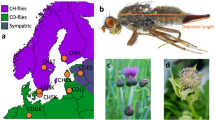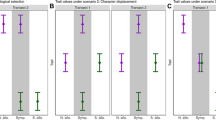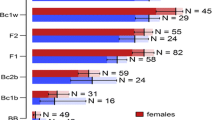Abstract
To explore genetic architecture and adaptive evolution, we conducted environmental and genetic experiments with two recently (ca. 100 generations) diverged, geographically adjacent races of the soapberry bug. One race occurs on a native host plant species, the other on an introduced host. We focused on three traits: length of the mouthparts, body size and development time. The first experiment was an environmental manipulation, comparing individuals of each population reared on one or the other host species (‘cross-rearing’) and estimating three evolutionary rates for each trait. The first rate, ‘evolutionary path’ compares ancestral-derived populations when both were reared on the introduced host. The second, ‘current ecological contrast’ compares populations with each reared on its natal host. The third, ‘evolved tradeoff’ compares the two races when reared on the native host. Differences among these rates are striking and informative. For example, development time, which appears to be relatively undifferentiated phenotypically, has actually evolved very rapidly via countergradient selection. The pattern differs for each trait, and clear developmental tradeoffs have evolved as quickly as adaptation to the new host in each. The second experiment was a two-generation ‘line cross’ study. With joint-scaling analyzes, we compared purebred, hybrid and backcrossed individuals to describe genetic architecture. Additive genetic variance for mouthpart length was consistently large (ca. 60%), but the interaction of dominance, maternal effects and epistasis was important in the other traits. Rearing host strongly affected genetic architecture. There was no clear relationship between genetic architecture and rate of evolution. Selection has produced both additive and nonadditive differentiation between the host races with surprising speed, consistent with theoretical predictions about evolution in fitness-associated traits.
Similar content being viewed by others
References
Armbruster, P., W.E. Bradshaw & C.M. Holzapfel, 1997. Evolution of the genetic architecture underlying fitness in the pitcher-plant mosquito, Wyeomyia smithii. Evolution51: 451–458.
Armbruster, P.A., W.E. Bradshaw & C.M. Holzapfel, 1998. Effects of postglacial range expansion on allozyme and quantitative genetic variation in the pitcher-plant mosquito, Wyeomyia smithii. Evolution 52: 1697–1704.
Bradshaw, W.E. & C.M. Holzapfel, 2000. The evolution of genetic architecture and the divergence of natural populations, pp. 245–263 in Epistasis and the Evolutionary Process, edited by J.B. Wolf, E.D. Brodie III & M.J. Wade. Oxford University Press, Oxford.
Brodie III, E.D., 2000. Why evolutionary genetics does not always add up, pp. 3–19 in Epistasis and the Evolutionary Process, edited by J.B. Wolf, E.D. Brodie III & M.J. Wade. Oxford University Press, Oxford.
Carroll, S.P., 1991. The adaptive significance of mate guarding in the soapberry bug, Jadera haematoloma (Hemiptera: Rhopalidae). J. Insect Behav. 4: 509–530.
Carroll, S.P. & C. Boyd, 1992. Host race radiation in the soapberry bug: natural history, with the history. Evolution 46: 1052–1069.
Carroll, S.P. & P.S. Corneli, 1999. The evolution of behavioral reaction norms as a problem in ecological genetics: theory, methods and data, pp. 52–68 in The Evolution of Behavioral Phenotypes; Perspectives from the Study of Geographic Variation, edited by S. Foster & J. Endler. Oxford University Press, Oxford.
Carroll, S.P. & H. Dingle, 1996. The biology of post-invasion events. Biological Conserv. 78: 207–214.
Carroll, S.P., H. Dingle & S.P. Klassen, 1997. Genetic differentiation of fitness-associated traits among rapidly evolving populations of the soapberry bug. Evolution51: 1182–1188.
Carroll, S.P., H. Dingle & S.P. Klassen, 1998. Rapidly evolving adaptations to host ecology and nutrition in the soapberry bug. Evol. Ecol. 12: 955–968.
Carroll, S.P. & J.E. Loye, 1987. Specialization of Jadera species (Hemiptera: Rhopalidae) on seeds of the Sapindaceae, and coevolution of defense and attack. Ann. Entomol. Soc. Amer. 80: 373–378.
Cockerham, C.C., 1986. Modifications in estimating the number of genes for a quantitative character. Genetics 114: 659–664.
Conover, D.O. & E.T. Schultz, 1995. Phenotypic similarity and the evolutionary significance of countergradient variation. Trends Ecol. Evol. 10: 248–252.
Craig, J.K. & C.J. Foote, 2001. Countergradient variation and secondary sexual color: phenoytpic convergence promotes genetic divergence in carotenoid use between sympatric anadromous and nonanadromous morphs of sockeye salmon (Oncorhynchus nerka). Evolution 55: 380–391.
Crnokrak, P. & D.A. Roff, 1995. Dominance variance: associations with selection and fitness. Heredity 75: 530–540.
Endler, J.A, 1986. Natural Selection in the Wild. Princeton University Press, Princeton.
Fenster, C.B. & L.F. Galloway, 2000. The contribution of epistasis to the evolution of natural populations: a case study of an annual plant, pp. 232–244 in Epistasis and the Evolutionary Process, edited by J.B. Wolf, E.D. Brodie III & M.J. Wade. Oxford University Press, Oxford.
Filchak, K.E., Roethele J.B. & J.L. Feder, 2000. Natural selection and sympatric divergence in the apple maggot Rhagoletis pomenella. Nature 407: 739–742.
Fisher, R.A., 1930. The Genetical Theory of Natural Selection. Clarendon Press, Oxford.
Gibbs, H.L. & P.R. Grant, 1987. Oscillating selection on Darwin' finches. Nature 327: 511–513.
Gingerich, P.D., 1983. Rates of evolution: effects of time and temporal scaling. Science 222: 159–161.
Gingerich, P.D., 1993. Quantification and comparison of evolutionary rates. Amer. J. Sci. 293A: 453–478.
Göllner-Scheidung, U., 1979. Die gattung Jadera Stål, 1862 (Heteroptera: Rhopalidae). Dtsch. Entomol. Z. 26: 47–75.
Gustafsson, L., 1986. Lifetime reproductive success and heritability: empirical support for Fisher' fundamental theorem. Amer. Natur. 128: 761–764.
Haldane, J.B.S., 1949. Suggestions as to quantitative measurement of rates of evolution. Evolution3: 51–56.
Hard, J.J., W.E. Bradshaw & C.M. Holzapfel, 1992. Epistasis and the genetic divergence of photoperiodism between populations of the pitcher-plant mosquito, Wyeomyia smithii. Genetics 131: 389–396.
Hard, J.J., W.E. Bradshaw & C.M. Holzapfel, 1993. The genetic basis of photoperiodism and evolutionary divergence among populations of the pitcher-plant mosquito, Wyeomyia smithii. Amer. Natur. 142: 457–473.
Hatfield, T., 1997. Genetic divergence in adaptive characters between sympatric species of stickleback. Amer. Natur. 149: 1009–1029.
Hendry, A.P. & M.T. Kinnison, 1999. The pace of modern life: measuring rates of contemporary microevolution. Evolution 53: 1637–1653.
Hendry, A.P., J.K. Wenburg, P. Bentzen, E.C. Volk & T.P. Quinn, 2000. Rapid evolution of reproductive isolation in the wild: evidence from introduced salmon. Science 290: 516–518.
Houle, D., 1992. Comparing evolvability of quantitative traits. Genetics 130: 195–204.
Houle, D., B. Morikawa & M. Lynch, 1996. Comparing mutational variabilities. Genetics 143: 1467–1483.
Kinnison, M.T. & A.P. Hendry, 2001. The pace of modern life. II. from rates to pattern and process. Genetica 112-113: 145–164.
Kruuk, L.E.B., T.H. Clutton-Brock, J. Slate, S. Pemberton & F.E. Guiness, 2000. Heritability of fitness in a wild mammal population. PNAS 97: 698–703.
Lair, K.P., W.E. Bradshaw & C.M. Holzapfel, 1997. Evolutionary divergence of the genetic architecture underlying photoperiodism in the pitcher plant mosquito, Wyeomyia smithii. Genetics 147: 1873–1883.
Lande, R., 1981. The minimum number of genes contributing to quantitative variation between and within populations. Genetics 99:541–553.
Laughlin,1965. Capacity for increase: a useful population statistic. J. Anim. Ecol. 34: 77–91.
Lynch, M. & B. Walsh, 1998. Genetics and Analysis of Quantitative Traits. Sinauer Associates, Sunderland, MA.
Mather, K. & J.L. Jinks, 1982. Biometrical Genetics: The Study of Continuous Variation. Chapman & Hall, London.
Meffert, L.M., 2000. The evolutionary potential of morphology and mating behavior: the role of epistasis in bottlenecked populations, pp. 177–193 in Epistasis and the Evolutionary Process, edited by J.B. Wolf, E.D. Brodie III & M.J. Wade. Oxford University Press, Oxford.
Merilä, J. & B.C. Sheldon, 1999. Genetic architecture of fitness and nonfitness traits: empirical patterns and development of ideas. Heredity 83: 103–109.
Merilä, J. & B.C. Sheldon. 2000. Lifetime reproductive success and heritability in nature. Amer. Natur. 155: 301–310.
Mousseau, T.A. & D.A. Roff, 1987. Natural selection and heritability of fitness components. Heredity 59: 181–197.
Orr, H.A. & J.A. Coyne. 1992. The genetics of adaptation: a reassessment. Amer. Natur. 140:725–742.
Price, T. & D. Schluter, 1991. On the low heritability of life history traits. Evolution 45: 853–861.
Reznick, D. & C.K. Ghalambor, 2001. The population ecology of contemporary adaptations: what empirical studies reveal about the conditions that promote adaptive evolution. Genetica 112- 113: 183–198.
Roff, D.A., 1998. Evolutionary Quantitative Genetics. Chapman and Hall, London.
Roff, D.A. & T.A. Mousseau, 1987. Quantitative genetics and fitness: lessons from Drosophila. Heredity 59: 103–118.
Searle, S.R., 1971. Linear Models. Wiley, NY.
Southwood, T.R.E., 1977. Habitat, the template for ecological strategies? J. Anim. Ecol. 46: 337–365.
Thompson, J.N., 1998. Rapid evolution as an ecological process. Trends Ecol. Evol. 13: 329–332.
Via, S., A.C. Bouck & S. Skillman, 2000. Reproductive isolation between divergent races of pea aphids on two hosts. II. Selection against migrants and hybrids in the parental environments. Evolution 54: 1626–1637.
Wolf, J.B., E.D. Brodie III & M.J. Wade, 2000. Epistasis and the Evolutionary Process. Oxford University Press, Oxford.
Wright, S., 1931. Evolution in Mendelian populations. Genetics 16: 97–159.
Author information
Authors and Affiliations
Rights and permissions
About this article
Cite this article
Carroll, S.P., Dingle, H., Famula, T.R. et al. Genetic architecture of adaptive differentiation in evolving host races of the soapberry bug, Jadera haematoloma . Genetica 112, 257–272 (2001). https://doi.org/10.1023/A:1013354830907
Issue Date:
DOI: https://doi.org/10.1023/A:1013354830907




